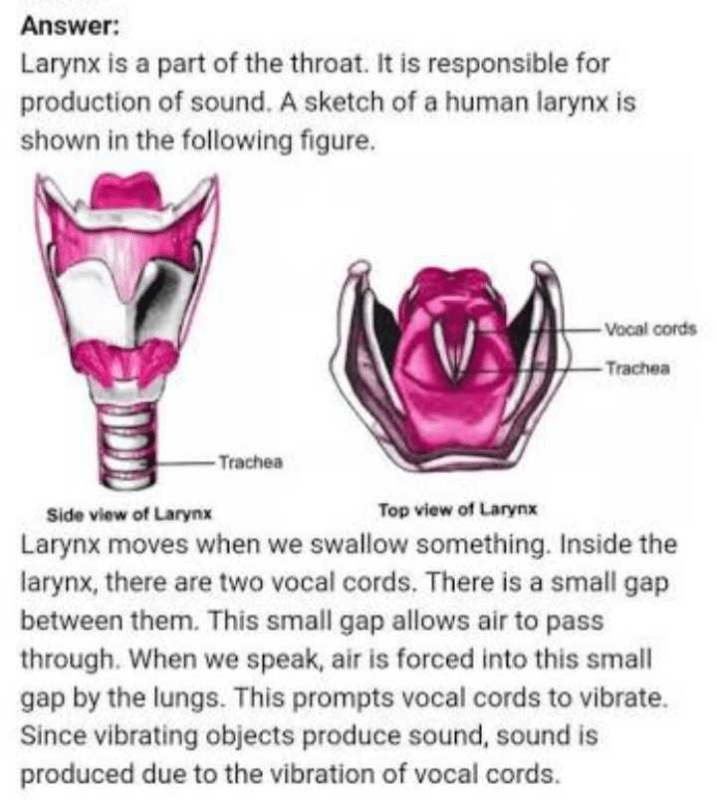Class 8 Exam > Class 8 Questions > Sketch larynx and explain its function?
Start Learning for Free
Sketch larynx and explain its function?
Community Answer
Sketch larynx and explain its function?
Larynx:
The larynx, commonly known as the voice box, is an important structure located in the throat. It is made up of cartilage and muscles and is situated between the pharynx and the trachea. The larynx plays a crucial role in various functions related to respiration and phonation.
Structure of the Larynx:
1. Cartilages: The larynx consists of several cartilages, including the thyroid cartilage, cricoid cartilage, and arytenoid cartilages. The thyroid cartilage forms the Adam's apple, which is more prominent in males. The cricoid cartilage is connected to the top of the trachea and acts as a base for the other cartilages. The arytenoid cartilages are responsible for the movement and tension of the vocal cords.
2. Vocal Cords: Inside the larynx, there are two pairs of vocal cords - the upper vestibular folds and the lower vocal folds. The lower vocal folds, also known as the true vocal cords, are responsible for producing sound during phonation.
3. Epiglottis: The epiglottis is a leaf-shaped cartilage located above the larynx. It helps prevent food and liquid from entering the trachea during swallowing by covering the opening of the larynx.
Function of the Larynx:
1. Phonation: The primary function of the larynx is to produce sound for speech. This is achieved through the vibration of the vocal cords. When air passes through the larynx, the vocal cords close together and vibrate, producing different pitches and tones. The muscles of the larynx control the tension and position of the vocal cords, allowing us to produce a wide range of sounds.
2. Protection: The larynx also plays a vital role in protecting the airway during swallowing. When we swallow, the epiglottis closes over the larynx, directing food and liquid into the esophagus and preventing them from entering the trachea. This helps to prevent choking and aspiration.
3. Respiration: The larynx is involved in the regulation of airflow during respiration. It contains muscles that adjust the size of the airway, allowing for increased or decreased airflow as needed. The vocal cords can also close tightly to prevent foreign objects from entering the respiratory system.
Conclusion:
In summary, the larynx is a crucial structure involved in phonation, protection of the airway, and regulation of respiration. It consists of various cartilages, vocal cords, and the epiglottis, all working together to facilitate speech production, prevent choking, and control airflow.
The larynx, commonly known as the voice box, is an important structure located in the throat. It is made up of cartilage and muscles and is situated between the pharynx and the trachea. The larynx plays a crucial role in various functions related to respiration and phonation.
Structure of the Larynx:
1. Cartilages: The larynx consists of several cartilages, including the thyroid cartilage, cricoid cartilage, and arytenoid cartilages. The thyroid cartilage forms the Adam's apple, which is more prominent in males. The cricoid cartilage is connected to the top of the trachea and acts as a base for the other cartilages. The arytenoid cartilages are responsible for the movement and tension of the vocal cords.
2. Vocal Cords: Inside the larynx, there are two pairs of vocal cords - the upper vestibular folds and the lower vocal folds. The lower vocal folds, also known as the true vocal cords, are responsible for producing sound during phonation.
3. Epiglottis: The epiglottis is a leaf-shaped cartilage located above the larynx. It helps prevent food and liquid from entering the trachea during swallowing by covering the opening of the larynx.
Function of the Larynx:
1. Phonation: The primary function of the larynx is to produce sound for speech. This is achieved through the vibration of the vocal cords. When air passes through the larynx, the vocal cords close together and vibrate, producing different pitches and tones. The muscles of the larynx control the tension and position of the vocal cords, allowing us to produce a wide range of sounds.
2. Protection: The larynx also plays a vital role in protecting the airway during swallowing. When we swallow, the epiglottis closes over the larynx, directing food and liquid into the esophagus and preventing them from entering the trachea. This helps to prevent choking and aspiration.
3. Respiration: The larynx is involved in the regulation of airflow during respiration. It contains muscles that adjust the size of the airway, allowing for increased or decreased airflow as needed. The vocal cords can also close tightly to prevent foreign objects from entering the respiratory system.
Conclusion:
In summary, the larynx is a crucial structure involved in phonation, protection of the airway, and regulation of respiration. It consists of various cartilages, vocal cords, and the epiglottis, all working together to facilitate speech production, prevent choking, and control airflow.

|
Explore Courses for Class 8 exam
|

|
Similar Class 8 Doubts
Sketch larynx and explain its function?
Question Description
Sketch larynx and explain its function? for Class 8 2025 is part of Class 8 preparation. The Question and answers have been prepared according to the Class 8 exam syllabus. Information about Sketch larynx and explain its function? covers all topics & solutions for Class 8 2025 Exam. Find important definitions, questions, meanings, examples, exercises and tests below for Sketch larynx and explain its function?.
Sketch larynx and explain its function? for Class 8 2025 is part of Class 8 preparation. The Question and answers have been prepared according to the Class 8 exam syllabus. Information about Sketch larynx and explain its function? covers all topics & solutions for Class 8 2025 Exam. Find important definitions, questions, meanings, examples, exercises and tests below for Sketch larynx and explain its function?.
Solutions for Sketch larynx and explain its function? in English & in Hindi are available as part of our courses for Class 8.
Download more important topics, notes, lectures and mock test series for Class 8 Exam by signing up for free.
Here you can find the meaning of Sketch larynx and explain its function? defined & explained in the simplest way possible. Besides giving the explanation of
Sketch larynx and explain its function?, a detailed solution for Sketch larynx and explain its function? has been provided alongside types of Sketch larynx and explain its function? theory, EduRev gives you an
ample number of questions to practice Sketch larynx and explain its function? tests, examples and also practice Class 8 tests.

|
Explore Courses for Class 8 exam
|

|
Signup to solve all Doubts
Signup to see your scores go up within 7 days! Learn & Practice with 1000+ FREE Notes, Videos & Tests.




























